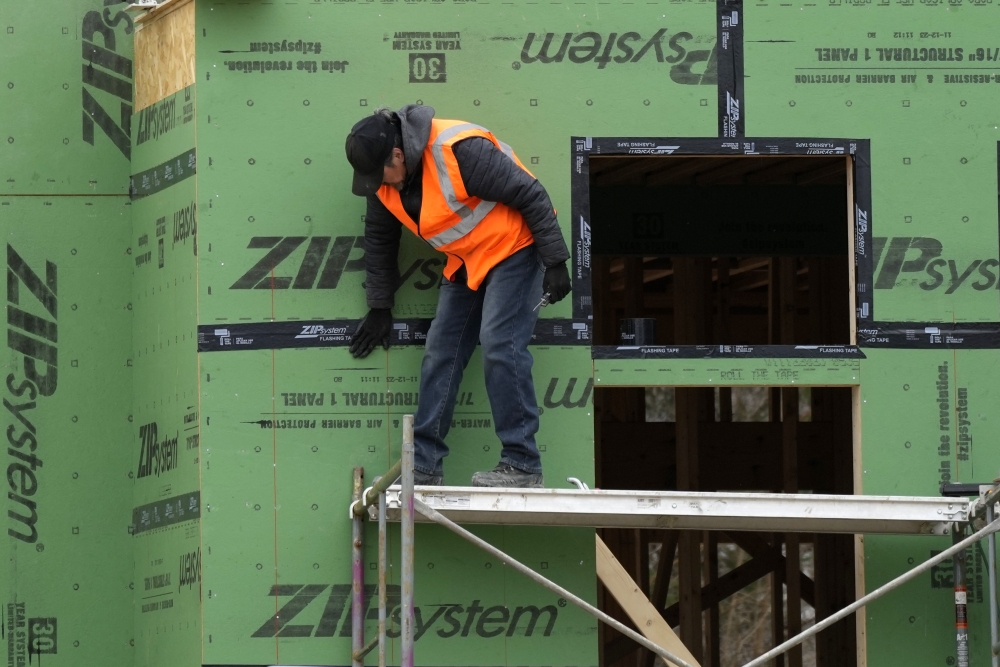Sign up for the Today newsletter
Get everything you need to know to start your day, delivered right to your inbox every morning.


This summer, despite the long-term warming of the Gulf of Maine and a long-term increase in the severity of weather events, conditions were so uneventful that Seal Island set a record for breeding puffins. Derrick Z. Jackson/Maine Monitor
From a bird blind on Seal Island, I watched as puffins zoomed in from the sea with a rainbow of fish drooping from their beaks.
They carried copper and golden juvenile haddock, redfish and white hake. Others had pink krill from massive upwellings that created magenta blotches just offshore.


A puffin returns to Seal Island with a fresh catch. Derrick Z. Jackson/The Maine Monitor
Some even carried bright silver herring: juicy fish that were once key prey for puffins in Maine. Atlantic herring are also a prime commodity for humans, who have overfished the species so badly that the fishery in New England has routinely been shut down early in recent years.
To see a number of puffins bringing herring to chicks was a stirring reminder of what the ocean can still offer.
Seal Island, which sits 21 miles off Rockland, was once home to the largest Atlantic puffin colony in the Gulf of Maine. It is now managed by the Audubon Seabird Institute, and was the second island that Audubon’s Project Puffin restored puffins to after a century’s absence spurred by hunting in the late 1800s. The first was Eastern Egg Rock, 6 miles off Pemaquid Point.
Both islands were seeded with puffin chicks brought from Newfoundland. Puffins began breeding anew on Eastern Egg Rock in 1981 and Seal Island in 1992.
This summer, despite the long-term warming of the Gulf of Maine and a long-term increase in the severity of weather events, conditions were so uneventful that Seal Island set a record for breeding puffins.
The crew of Coco Faber, Amiel Hopkins, Liv Ridley, Reed Robinson and Nacho Gutierrez counted 672 active puffin burrows, about 100 more than the last census five years ago. The total number of known burrows surpassed 1,000 for the first time.
Other birds also did well. Razorbills, a larger cousin of the puffin, established a record of 101 active burrows.
“The weights for the puffin chicks were just so good,” said Faber, 30, the crew supervisor. “Unlike many recent years when there were big shifts or drops in what puffin parents could find, this was a summer where they steadily found fish.”
That buoyant mood was shared on Matinicus Rock, another island 23 miles from Rockland, also managed by the Seabird Institute. Crew supervisor Tracey Faber, Coco’s sister, said that not only were the puffin chicks doing well, but Arctic tern and common tern nest numbers were up.
Common murres, another bird re-established in Maine after being gone for more than 100 years, fledged a record 16 chicks.
“We saw some great growth in some birds,” Tracey Faber said.
But elsewhere there were reminders that seabird islands in the Gulf of Maine are highly vulnerable.
Earlier this month, researchers at the Gulf of Maine Seabird Working Group gathered at a conference hosted by the Seabird Institute in Bremen.
One topic was the damage caused by last winter’s violent storms, particularly on Petit Manan Island, which sits off a stretch of Downeast coastline that got hammered in January.
Island supervisor Amanda McFarland and U.S. Fish and Wildlife Service biologist Linda Welch said the vast majority of natural sod burrows under relatively small rocks and artificial nesting structures were destroyed.
The artificial structures had been built by Welch over the years to entice puffins to breed higher up on the island.
This winter’s obliteration left puffin parents competing for available space, with multiple eggs in the same burrow complex and parents trying to roll unwanted eggs out of the way – puffins hatch and raise only one chick at a time.
“There was a nest of a 30-year-old nesting pair that was shot down the shoreline 30 feet. We found burrow markers tossed all over the island,” said McFarland. “It was so ironic and sad because the food for the puffins was so good.”
The island’s puffins saw one of their lowest birth rates in recent years.
“When I saw the damage, I almost started to cry,” Welch said. “We really need to think more than ever about taking a hard look at climate resilience for seabirds.”
This story was originally published by The Maine Monitor, a nonprofit and nonpartisan news organization. To get regular coverage from the Monitor, sign up for a free Monitor newsletter here.


GRAY, Maine (WABI) – A Windham man suffered serious injuries after a crash involving a motorcycle and an SUV in Gray Monday morning.
It happened on West Gray Road around 6:30 a.m.
The Cumberland County Sheriff’s Office says as 59-year-old Cheryl Royal of Gray was turning, a motorcycle driven by 50-year-old William Segler struck the driver’s side of Royal’s SUV.
Officials say Segler was taken to a Portland hospital with serious injuries.
Royal was not injured.
Investigators say Royal failed to yield to the right of way, but the crash remains under investigation.
Copyright 2025 WABI. All rights reserved.

Local News
A 26-year-old fisherman died Friday after he and another crew member were injured in an accident aboard their fishing boat off the North Shore, officials said.
Just before 4 p.m., the US Coast Guard responded to a distress call reporting that a snapped rope had struck two crew members on the 25 TO LIFE, a fishing vessel, according to spokesperson and Petty Officer 2nd Class Diolanda Caballero. The boat was located about 25 miles east of Nahant.
One of the crew members suffered a concussion and possible broken ribs, and the other, later identified as Jaxson Marston, had a broken neck and was “intermittently unresponsive,” Caballero said in a statement.
The Coast Guard launched response boats and diverted a helicopter to aid in the recovery, according to officials. Shortly after 5 p.m., one of the response boats reached the 25 TO LIFE and delivered the two crew members to a Gloucester pier.
The crew members were transferred to emergency medical services and taken to Beverly Hospital, where Marston was pronounced dead on arrival, officials said.
Marston was originally from Addison, Maine, according to the Bangor Daily News. Josh Stubbs, a member of the town’s select board, said on Facebook that he loved Marston “like a brother.”
“I have had trouble all day trying to find the right words to say,” Stubbs wrote. “I have known you for a long time. But the last years we have been close. I don’t know what to do.”
Cape Ann Lobstermen, a fish market in Gloucester, started a fundraiser to provide for Marston’s family, scallop fisherman Jesse Roche posted on Facebook. For the fundraiser, fishermen are encouraged to donate a bag of scallops out of their final catch, with the proceeds going to the family.
Maine State Representative Tiffany Strout offered her condolences on Facebook.
“Jaxson, only 26 years old, a husband, a dad, hard worker, passionate hunter and a freind to many was doing what he had done many times before, just trying to earn an honest living to support his family,” she wrote. “Now his family can use all the support as they try to move forward with the loss of their loved one.”
Strout also encouraged community members to keep the other crew member and his family in their thoughts, writing that he “needs all the support for him and his family as he tries to recover from his injuries.”
“A reminder that life is short, things can change in an instant and sometime accidents just happen, even with the most caution and readiness,” Strout wrote. “Please keep the fishermen’s family’s in your thoughts and give your family and friends big hugs as I am sending big hugs to the families.”
Get everything you need to know to start your day, delivered right to your inbox every morning.

I read Peter Ryner’s April 12 op-ed, “Zoning won’t solve Maine’s housing crisis — and zoning didn’t create it,” with interest. His central assertion, “Zoning … is neither the source nor the solution to Maine’s housing problems” is incorrect and not supported by his argument. Many cities, towns and villages in Maine could not be rebuilt today. Most buildings in these places are “non-conforming,” i.e., they don’t meet current zoning regulations.
In many instances, municipalities have applied suburban building standards to their traditional town centers. Requiring a half-acre lot in the center of a town or village doesn’t just prevent the “warehousing” of people, as Mr. Ryner frets, it prevents the building of anything at all. Not only are most towns not adding housing to their historic centers but, as housing is lost, it’s not being replaced. This is bad and we should address the problem: outdated zoning regulations.
Maine’s recent law permitting accessory dwelling units statewide was a good step in the right direction. Still, we must do better. Allowing, and encouraging, the “thickening up” of the historic centers of our cities and towns would be a great place to start. Eliminating minimum lot sizes, shifting to a focus on form rather than use or density and, perhaps, eliminating zoning requirements altogether around transit hubs would all be good next steps.
Zoning reform is not a panacea, however any meaningful expansion of housing opportunity will require at the hard look at the constraints zoning imposes.
Brian Banton
Topsham
Harvard would be smart to follow Hillsdale’s playbook. Trump should avoid Biden’s. | Opinion


Video: Hegseth Attacks the Media Amid New Signal Controversy


New Poetry Books That Lean Into Calm and Joy Amid Life’s Chaos


Maps: Where Do Federal Employees Work in America?


Pete Hegseth reportedly spilled Yemen attack details in another Signal chat


Pope Francis and US presidents: A look back at his legacy with the nation's leaders


New Zealand’s minor gov’t party pushes to define women by biological sex


JD Vance has ‘exchange of opinions’ on issues like deportations during meeting with top Vatican official